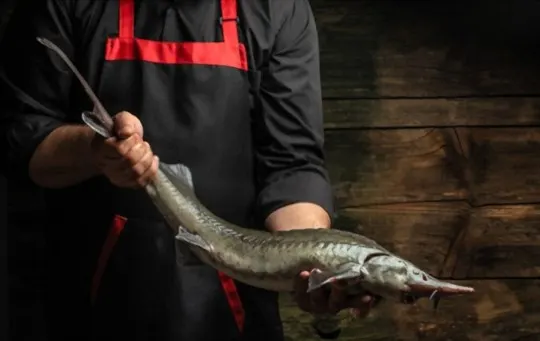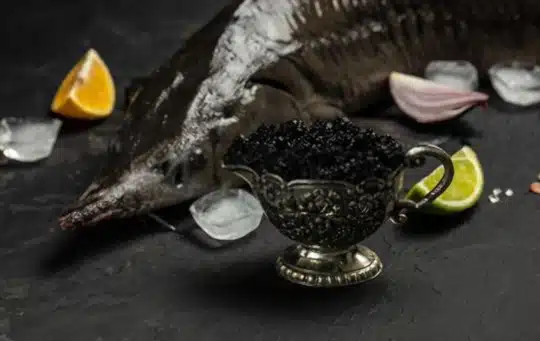Have you been curious to know what sturgeon tastes like? If yes, you’re in luck.
Here, we’re bringing you all the knowledge on the flavor and texture of sturgeon.
Get ready to delight your taste buds with something unique.
You’ll also learn about why it’s a popular choice for chefs around the world.
What is Sturgeon?

Sturgeon is a large, ancient fish that has been around for over 250 million years.
It is prized for its flavorful flesh and caviar, which is a delicacy made from the fish’s eggs.
Sturgeon flesh is dense, meaty, and versatile, with a mild flavor that is often compared to that of halibut or swordfish.
The taste of sturgeon can vary depending on the species, the diet, and the preparation method used.
Sturgeon can be grilled, roasted, smoked, or poached and paired with a variety of seasonings and sauces to enhance its natural flavor.
It is a good source of protein, omega-3 fatty acids, and other important nutrients.
When buying sturgeon, look for flesh that is firm, shiny, and has a fresh, briny scent.
For the best flavor, choose sustainably-farmed or wild-caught sturgeon from a trusted source.
What Does Sturgeon Taste Like?

Sturgeon is a versatile fish that can be prepared in various ways, and its taste depends on the species, diet, and cooking method.
Here are some general taste profiles of sturgeon meat from different species:
- Beluga Sturgeon: This species has a rich, buttery flavor and a velvety texture that melts in your mouth. The caviar of Beluga Sturgeon is considered a delicacy for its smooth and delicate flavor.
- Russian Sturgeon: The meat is firmer and more delicate than Beluga, with a mild and nutty flavor that complements different seasonings and sauces.
- Sterlet Sturgeon: Sterlet has a delicate and mildly sweet flavor that is less overpowering than other sturgeon varieties. This variety is often smoked or grilled to bring out its flavor.
Generally, sturgeon meat is lean, firm, and meaty, with a mild flavor that can be enhanced with different spices, herbs, and sauces.
It’s an excellent source of protein, low in fat, and suitable for various cooking methods such as grilling, smoking, baking, and frying.
Factors that Affect the Taste of Sturgeon

The taste of sturgeon can be affected by many factors, such as the age of the fish, their diet, and the method of preparation.
Here are some of the major factors that can influence the taste of sturgeon:
- Age: As sturgeon age, their meat tends to become firmer and leaner, resulting in a more flavorful and desirable taste.
- Diet: The diet of sturgeon can impact the taste of their meat, depending on what they consume. Sturgeon that feed on a natural diet of small fish and crustaceans tend to have a more delicate and clean taste compared to sturgeon that are raised on commercial feed.
- Method of Preparation: Sturgeon can be prepared in a wide variety of ways, including smoking, grilling, baking, and frying, and each method can impart its unique flavor profile. For example, smoked sturgeon has a rich and smoky taste, whereas baked or grilled sturgeon has a delicate and mild flavor.
- Environment: The water source and temperature where sturgeon are raised can also influence their taste. Sturgeon raised in cold, clean waters tend to have a more pronounced flavor than those raised in warmer, less clean waters.
Keeping these factors in mind can help you select the best sturgeon product for your desired taste profile and prepare it in a manner that enhances its natural flavors.
1 – Species and Age
The species and age of sturgeon greatly influence its taste, texture, and aroma.
Here’s everything you need to know about what sturgeon tastes like:
- Beluga sturgeon: This species produces the most coveted and expensive caviar in the world. The flesh of beluga sturgeon is buttery, delicate, and slightly sweet, with a creamy texture.
- Ossetra sturgeon: This species produces caviar that is slightly smaller in size and lighter in color than beluga caviar. The flesh of Ossetra sturgeon has a nutty and slightly sweet flavor, with a firmer texture than beluga.
- Siberian sturgeon: This species is known for its firm texture, mild flavor, and gray flesh.
- White sturgeon: This is the most common species of sturgeon and is often farmed for its caviar. The flesh of white sturgeon is pinkish in color, with a mild flavor and firm texture.
- Green sturgeon: This species has a more delicate flesh and a subtle flavor compared to other sturgeon species, with a hint of sweetness.
The age of the sturgeon also affects its taste, with younger sturgeon having a milder flavor and firmer texture than older sturgeon.
Additionally, the way that the sturgeon is cooked or prepared can also influence its taste and texture.
Overall, sturgeon is a versatile and flavorful fish with a range of taste profiles depending on the species and age.
2 – Diet and Environment
Sturgeon is a popular fish known for its mild taste that can be described as a cross between swordfish and halibut.
The flavor and texture of sturgeon vary depending on multiple factors such as diet, habitat, and environment.
In general, sturgeon has a meaty texture that is softer than swordfish and firmer than halibut.
The fish is also low in fat, which makes it an excellent choice for healthy eating.
The unique taste of sturgeon is due to the feeding habits of the fish.
The fish feeds on a diet of fish, crustaceans, and mollusks, which makes the fish’s taste similar to that of its prey.
Sturgeon that are harvested in the wild from cold water environments, such as the Caspian Sea, have a more robust flavor and firmer texture than farmed sturgeon.
When cooking sturgeon, it is essential to avoid overcooking, which can result in a dry and tough texture.
A simple technique to prepare sturgeon is to grill or bake it with olive oil, salt, and pepper.
Alternatively, you can cook it in a sauce or marinade to enhance its flavor.
3 – Preparation Method
Sturgeon is a prized fish commonly found in major rivers and lakes worldwide.
It has a rich, buttery flavor that is often described as a mix between the mild taste of cod and the rich taste of salmon.
The preparation method also plays a significant role in how sturgeon tastes.
Here are some ways to prepare sturgeon to make it taste delicious:
- Grilled: Grilling sturgeon is a great way to enhance its natural flavor. Season the fish with some salt, pepper, and garlic powder, and then grill it over medium-high heat until cooked through.
- Smoked: Sturgeon can also be smoked to add a bold, smoky flavor. Use a smoker or smoke box to smoke the fish over your choice of wood, such as hickory or applewood.
- Pan-Seared: Pan-searing is a quick and easy way to cook sturgeon while retaining its natural flavor. Heat some butter in a pan over medium-high heat, and then add the seasoned fish. Cook for 3-4 minutes on each side until golden brown and cooked through.
How to Cook Sturgeon to Enhance its Flavor?

Sturgeon has a flavor profile that is often described as mild, buttery, and slightly sweet.
Cooking sturgeon properly enhances its natural flavors and textures.
Here are some tips to help you cook sturgeon to perfection:
- Grilling: Grilling sturgeon over a medium heat allows it to develop a smoky flavor with a crispy exterior and moist interior.
- Baking: Baking sturgeon with a drizzle of olive oil or butter and lemon juice at 350°F for 15-20 minutes brings out its natural sweetness and delicate texture.
- Pan-frying: Frying sturgeon in a skillet with a little oil on medium heat is another excellent option. It helps to create a golden-brown crust on the outside while keeping the inside moist and flaky.
- Smoking: Smoking sturgeon with wood chips (hickory or apple are great options) infuses its delicate flavors with a rich smokiness.
Whichever method you choose, it is essential to monitor the internal temperature of the fish.
Sturgeon should be cooked to an internal temperature of 145°F.
Overcooking can make the flesh dry and rubbery.
Pro Tip: Before cooking sturgeon, remove the skin to prevent it from becoming rubbery.
Is Sturgeon Healthy?
Sturgeon is not only delicious but it also has various health benefits.
It is a good source of protein, omega-3 fatty acids, vitamins, and minerals, making it a healthy and nutritious food choice.
Here are some of the health benefits of sturgeon:
- Rich in omega-3 fatty acids: Omega-3 fatty acids are essential for maintaining good heart health and reducing the risk of heart disease. Sturgeon is a great source of these healthy fats, which can also aid in reducing inflammation in the body.
- Good source of protein: Sturgeon is high in protein, which can help build and repair muscles, skin, and other tissues in the body.
- Contains vitamins and minerals: Sturgeon is rich in vitamins B12, D, and E, as well as minerals such as iron, zinc, and calcium.
- Low in calories: Sturgeon is a low-calorie food, making it an excellent food choice for those watching their weight.
Now, coming to the taste of sturgeon, it has a unique and delicate flavor that is often compared to a mild and buttery swordfish or shark.
The texture is firm and meaty, and the taste is often described as earthy, slightly sweet, and nutty.
It can be prepared in various ways, including grilling, smoking, or pan-searing, and pairs well with a variety of seasonings and sauces.
Where to Buy Sturgeon and How to Store It?

Sturgeon is a highly-prized fish variety that is often referred to as the ‘king of fish.
‘ While sturgeon meat has a reputation for being both expensive and rare, it is possible to find it at specialized markets or online retailers.
When it comes to storing sturgeon, it is essential to keep it at a consistent temperature to preserve its delicate flavor and texture.
Here are some tips on where to buy sturgeon and how to store it:
Where to buy:
If you are looking to buy sturgeon, you can try one of the following options:
- Visit a local fish market or specialty store that carries a variety of fish.
- Check online retailers that offer fresh and frozen sturgeon.
- Try a restaurant that serves sturgeon to get a feel for its flavor and texture before you buy your own.
How to store:
Once you have purchased your sturgeon, make sure to follow these guidelines for optimal storage:
- Store it in the coldest part of the fridge (usually the back) at a temperature of 31.1°F (-0.5°C) or lower.
- Keep it in its original packaging or a resealable plastic bag.
- Consume it within three days of purchase for optimal freshness.
If you can’t find fresh sturgeon, you can also try smoked or canned varieties that are readily available online or at specialty stores.
Conclusion
In conclusion, sturgeon has a rich, buttery and mild taste with a tender and delicate texture.
Its flavor profile can be compared to that of a cross between swordfish and halibut, with a slightly nutty and sweet undertone.
The taste of sturgeon is largely dependent on its age, size, and the environment it has been raised or caught in.
Sturgeon meat is incredibly versatile and can be prepared in a variety of ways, including baking, grilling, smoking, or frying.
It is packed with nutrients and health benefits, including high levels of Omega-3 fatty acids, protein, and vitamin B12.
So if you have not tried sturgeon yet, go ahead and give it a try.
You never know, it might just become your new favorite seafood.

What Does Sturgeon Taste Like? A Comprehensive Guide
Ingredients
- Sturgeon
- Ingredients from your selected recipes
Instructions
- Select your favorite ingredient from the range available in this article.
- Collect all the necessary items to make the recipe.
- Use the instructions provided to prepare a delicious dish in 30 minutes or less.

Carrie is a food writer and editor with more than 15 years of experience. She has worked for some of the biggest names in the food industry, including Bon Appétit, Food & Wine, and Martha Stewart Living.
As the Editor in Chief of IntroChicago.com, Carrie oversees all of the content on the site. She also manages the team of contributing writers and editors, who help to create delicious recipes, helpful tips, and informative articles that you’ll find on the site.
A native of the Chicago area, Carrie is passionate about all things food. She loves trying new restaurants and experimenting with new recipes in her kitchen. She’s also a graduate of the Culinary Institute of America, so she knows a thing or two about food!
